Schedule a Call
Get started with your organic growth journey!



Get insights on AI, productivity, and the future of work.



Marketing your window and door business online should be simple and effective.
The key is making sure that when homeowners need your services, they can easily find you. By applying the right strategies, you can increase your visibility, attract more customers, and turn those website visits into real projects.
And the best part? You don’t need a large budget to see results.
This guide will show you practical, no-fuss strategies that will help your business grow, stand out online, and bring in more inquiries without the complexity.
When a homeowner has a window that won’t open or a door that won’t close, they usually search online for help. They’re looking for someone who can fix it fast. If your business isn’t visible, another contractor will be the one to answer the call.
Marketing is how you ensure you’re there when homeowners need you most.
With so many choices out there, it’s vital to show homeowners why you’re the right contractor for their window and door needs.
The right marketing strategies make sure people remember you. By reaching the right audience with the right message, you can turn casual interest into committed customers. When your business is present at the right moment, it leads to more jobs and steady growth.
A strong online presence is crucial for attracting and converting local customers for your window and door business. By optimizing your digital platforms, improving local SEO, and engaging with potential customers through social media and reviews, you can significantly increase visibility and drive business growth.
Here’s how to make sure you’re using every resource to its full potential:
Google Business Profile and Apple Business Connect are essential tools for increasing your visibility when homeowners search for window and door services in your area.
Properly optimizing your site will help you stand out and attract more local customers.
Google Business Profile Optimization:
Apple Business Connect Optimization:
Actionable Tip: Keep your profiles active and consistent by updating details, adding fresh photos, and engaging with customer reviews. A well-maintained profile can significantly improve your visibility and attract more leads.
Your website is your storefront, your brand, and your first impression, all rolled into one. When someone lands on your page, they’re looking to see if you can solve their problem. A clean, easy-to-navigate website can make a big difference.
The goal is to make people want to pick up the phone and hire you. Think of your website as a welcoming space that drives action.
Key Elements for Optimization:
Actionable Tip: Highlight your work with engaging content like project photos and descriptions. Ensure your contact details are easily accessible, especially on mobile devices.
When homeowners search for “window installation” or “door replacement,” they’re looking for a local contractor they can trust.
Local SEO ensures that when they’re searching, you’re right there, ready to help. You need to make sure your business shows up in searches from people who live near you, people who need your services now.
Strategies:
Actionable Tip: Incorporate city or neighborhood-specific terms on your website to target local customers and enhance visibility in local search results.
Google Ads and PPC campaigns are powerful tools to get your window and door business in front of customers exactly when they need you.
By targeting users actively searching for your services, these ads ensure you're visible at the moment it counts, helping you capture more leads.
PPC Tips:
Actionable Tip: Target high-intent search terms like “window replacement” in your ads and ensure they’re optimized for mobile. Review ad performance regularly and make necessary adjustments to improve results.
Social media is a place to build connections, show off your work, and engage with customers in real-time. Facebook, Instagram, and TikTok are powerful tools that help you showcase your projects and expertise.
Using social media to its full potential can help you reach a wider audience and create a personal connection with potential customers. People like doing business with those they feel they know and trust.
Strategies:
Actionable Tip: Regularly post engaging content that showcases your projects, and run local-targeted ads to attract the right audience in your area.
Customer reviews are crucial for building trust and boosting your search rankings. Positive feedback showcases your reliability, while responding to reviews shows you value customer satisfaction.
A good review can be the deciding factor in whether a potential customer chooses you over a competitor.
Review Management Tips:
Actionable Tip: Encourage satisfied customers to leave reviews, and make sure to respond to all feedback promptly. Highlight positive reviews to attract new clients.
Retargeting ads and automated emails help you stay visible to potential customers who’ve already shown interest.
By keeping your business in front of them, these tools ensure you remain top of mind until they're ready to take action.
Key Tactics:
Actionable Tip: Implement retargeting ads and automated email sequences to stay top of mind for customers who visited your site but didn’t convert.
To grow your window and door business effectively, you need to know what’s working and what’s not. Marketing is an investment, and understanding how to measure your success will help you get the most out of your efforts.
Let’s break it down into simple steps, so you can track your progress without feeling overwhelmed.
What You Need to Keep an Eye On:
Actionable Tip: Track performance metrics like customer inquiries, ad results, and website bounce rate to identify what’s working and adjust accordingly.
To start seeing real growth, focus on making your business visible to homeowners when they need your services most.
By applying the right tools and methods, like optimizing your Google Business Profile, incorporating local SEO, and engaging with customers on social media, you can increase visibility, build trust, and ultimately convert more inquiries into jobs.
With the right strategies in place, you don’t need to break the bank to see results.
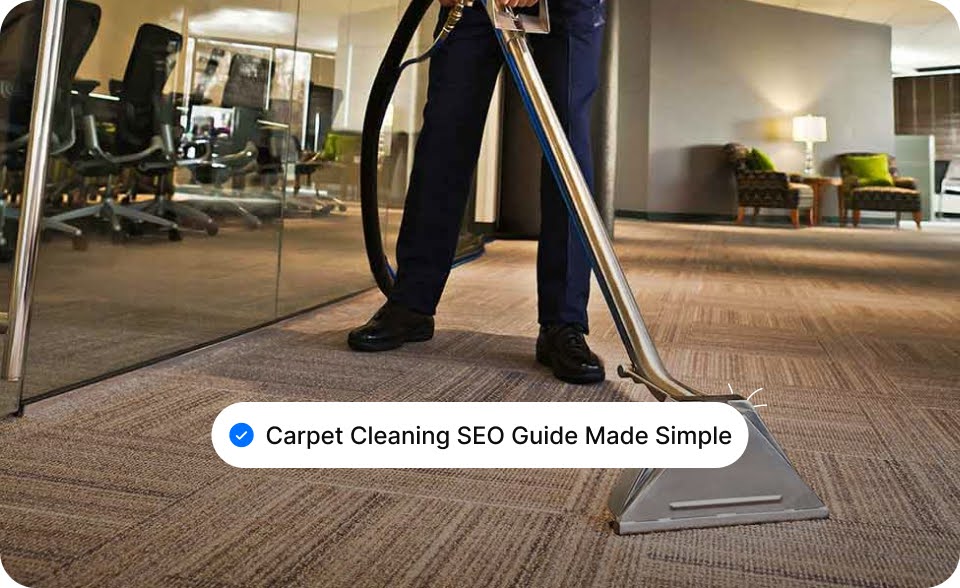
You could be the best carpet cleaner in your city, punctual, polite, and thorough, but if no one can find you online, your phone stays quiet. That’s the frustrating part: your quality isn’t the problem. Visibility is.
Today, people don’t ask neighbors first; they ask Google. And if your business doesn’t show up there, someone else gets the job, usually a company that’s not even half as good as you.
Carpet cleaning SEO ensures your business shows up when someone nearby searches for what you do best. It helps your name, your reviews, and your work get seen by the right people at the right time.
In this blog, we’ll walk through what carpet cleaning SEO really is, what a proper setup looks like, and how you can use simple steps to get found, trusted, and booked more often.
Carpet cleaning SEO is the process of helping your carpet cleaning business show up in local search results when people nearby look for services.
In plain terms, it’s how you make sure potential customers find your business first when they’re ready to book a cleaning.
When someone searches for a local carpet cleaner, Google checks a few things before showing results:
Your SEO efforts strengthen these signals. Most homeowners start their search online before calling a carpet cleaner. They want someone nearby, available soon, and trustworthy.
Understanding how SEO works is one thing, but seeing it in action is where the picture gets clear.
Here’s what makes an effective setup and how to get each part right:
If SEO had a front door, this would be it. Your Google Business Profile is what most people see first, even before your website. It’s your online business card, review hub, and map pin all in one.
What to do:
Your website should be built for humans first and then for Google. For that, your website needs to help people understand what you do and make it easy to call or book.
What to include:
SEO keywords should sound like something your customers would actually type. That’s how Google connects your pages to the right people.
Examples:
Use these naturally in your page titles, subheadings, and a few times in the text. Also, write short meta descriptions (the small text under your page title in search results) that tell people what you offer and where.
Behind every good website is a bit of clean, technical work that keeps it fast and smooth. It’s about making sure nothing gets in the way of a good user experience.
Here’s what to check:
The best marketing is proof. When people see your real work, they trust you. When they read your reviews, they believe you. When both live on your website, they choose you.
What to do:
If your name, address, or phone number (NAP) is inconsistent online, Google gets confused, and so do customers. A clean online footprint helps you appear trustworthy.
What to do:
Bonus: when local partners (like realtors, cleaners, or landlords) mention your business online, those mentions help your SEO grow faster and improve your visibility across your service area.
SEO becomes much easier to understand when you break it into three parts. Each one helps your carpet cleaning business get found and trusted in a different way:
The next step is turning that visibility into something measurable, such as calls, bookings, and long-term customers. That’s where strategy comes in.
Once your website, service pages, and Google Business Profile are set up, the next step is to turn those tools into steady jobs. A good carpet cleaning SEO strategy helps you move beyond just being visible. It helps you attract better customers, get more calls, and build trust that lasts.
Here’s how to do that:
1. Track Which Calls Turn Into Real Jobs: Keep a small log of where each call comes from and whether it becomes a paying job. Over time, you’ll see which sources bring real customers and which ones don’t. This helps you focus on what’s actually working instead of guessing.
2. Test Small Changes on Your Website: Try changing a headline or button text and see if more people call. Simple tweaks like “Same-Day Cleaning” or “Get a Quick Quote” often boost results without needing more traffic.
3. Share Pricing and Availability Clearly: Most people hesitate because they don’t know the cost or timing. Add lines like “Starts at $79 per room” or “Same-day slots available before 11 AM.” Clear info makes calling easier and builds trust.
4. Automate Review and Referral Requests: Set up automatic texts or emails after each job. Ask for a review, then follow up with a small referral offer. This keeps new reviews and word-of-mouth leads coming in without extra effort.
5. Improve How Calls Are Answered: Listen to a few recorded calls (with notice). You’ll hear what customers worry about. Create a short script that covers price range, timing, and next steps. Confident answers lead to more bookings.
6. Offer Simple Maintenance Plans: Give customers the option to book yearly or twice-a-year cleanings at a small discount. It keeps business consistent and increases repeat work, which helps both revenue and SEO.
7. Add the Right Schema Tags: Ask your web person to install a few small codes like AggregateRating, Offer, and ImageObject. They don’t change your site visually, but they help Google understand your business better.
8. Get Mentioned Locally: Share small updates or stories with local community pages, neighborhood groups, or business partners. These mentions are strong local SEO signals and help you stay top-of-mind in your area.
9. Focus on High-Value Neighborhoods: Some areas bring better jobs. Test small ZIP-code-based promotions or posts, then create short pages for the neighborhoods that bring the best work.
10. Review Your Numbers Monthly: Check three things: calls from Google, booked jobs, and top-visited service pages. If something drops, adjust the photo, headline, or pricing. Small, steady improvements add up over time.
Check those numbers once a month. If one page or area drops, don’t panic. Tweak a photo, headline, or price. SEO is about small, steady changes that add up over time.
Mastering SEO for your carpet cleaning business is not a one-time task but an ongoing process. By optimizing your website, creating valuable content, and building your local presence, you’re setting your business up for long-term success.
Remember, the goal is to make sure your potential customers find you when they need you the most. With the right SEO strategies in place, you can turn search engine traffic into loyal clients who keep coming back.
So, take the steps today to elevate your business’s visibility, and watch your leads, and your reputation, grow. The right SEO approach is your key to staying ahead of the competition. Let’s get started!
SEO helps your business appear organically in search results without paying for each click, while Google Ads are paid listings that show up instantly but disappear once your budget runs out. With SEO, you build long-term visibility; with Ads, you get quick visibility that stops when you stop spending. A healthy business often uses both together.
Photos and short cleaning videos show Google (and customers) that your business is active and real. Uploading before-and-after pictures, job-site clips, or customer testimonials regularly helps your profile stay fresh and can boost your visibility in local searches. It also helps people trust you faster than words alone.
Yes, but do it carefully. Being listed on trusted platforms like Yelp, Angi, Thumbtack, Facebook, and local directories gives Google more proof that your business exists. Just make sure your name, address, and phone number (NAP) match exactly across all sites. Inconsistent listings confuse search engines and hurt your ranking.
You can handle the basics yourself like claiming your Google Business Profile, adding keywords, and collecting reviews. But if you want faster, more consistent results (especially across multiple service areas), hiring an SEO professional can help with technical fixes, content planning, and tracking progress properly.
Indirectly, yes. Social media posts, especially those tagged with your city or showcasing your work, create extra signals for Google that your business is active and locally relevant. They also drive visitors to your site, which helps improve engagement metrics that search engines consider when ranking local businesses.

Most buyers start their journey online. They search for models, compare prices, check inventory, and read reviews, often from their phones. For dealerships, that means being findable in the exact moments buyers are looking, and making each vehicle listing clear, useful, and trust-worthy.
SEO for the automotive industry is a marketing effort that makes your inventory, service pages, and dealership visible and impactful across search and map results. It’s the mix of local visibility, structured inventory data, strong on-page content, and technical hygiene that turns searches into showroom visits and phone calls.
In this blog, you’ll get hands-on steps for dealership SEO: what matters, how to structure it and the everyday checks that keep your leads steady and qualified.
SEO for automotive industry means optimizing everything a buyer might encounter online: your website, vehicle listings, Google Business Profile, and third-party inventory channels. This is important, so that people searching for vehicles, parts, or services find your dealership and trust your offer.
For dealers, this breaks down into three practical goals:
Most buyers start on Google. They search for known keywords like “used Honda Civic near me” or “best truck deals in Dallas,” and expect to see real vehicles, with real prices, from nearby dealerships. That’s exactly what modern automotive SEO supports.
Here’s what makes it especially important today:
Google’s vehicle ads and inventory listings let shoppers see your cars, make, model, price, mileage, right inside search results. But this only works if your inventory feed is accurate and up to date. The cleaner your data, the more often your vehicles appear in those high-intent searches.
Adding “Vehicle schema” (a small code that labels your vehicle details for Google) helps search engines read your listings properly. That means your vehicles can show up with richer info, like price, availability, and photos.
Your Google Business Profile and local landing pages are what push your dealership into the map section of results. That’s where buyers click for directions, reviews, and calls. A strong local presence means you’re visible to people already ready to test-drive or buy.
These three realities make dealership SEO measurable.
With the right SEO strategies, your dealership can show up where serious buyers are searching and convert clicks into customers. These proven approaches focus on visibility, trust, and consistent lead flow:
Local SEO is what puts your phone number, address, and reviews right in front of people ready to visit today. It turns nearby searchers into actual foot traffic.
If you sell cars in Austin, there’s no point showing up in Dallas searches. That’s why local SEO is the backbone of dealership marketing.
What to focus on:
Pro Tip: Keep your GBP updated monthly. Fresh photos, regular posts, and recent reviews signal to Google that your dealership is active and trustworthy.
Most dealership websites are cluttered: too many buttons, pop-ups, or generic “inventory” pages that all look the same. On-page SEO fixes that.
Key areas to improve:
Pro Tip: Your Vehicle Description Pages (VDPs) should behave like product pages: include keywords, specs, price, mileage, photos, and an easy “Book Test Drive” button.
If your website loads slowly, people leave. It’s that simple. Technical SEO ensures your site runs smoothly behind the scenes; no broken links, confusing URLs, or delays that make buyers hit “back.”
Key areas to check:
Pro Tip: Even small improvements to speed and mobile usability can increase leads. Fast-loading pages = happier buyers and better SEO.
You don’t need 100 blog posts to succeed. You just need useful content that answers buyer questions. When your content helps people with buying tips, maintenance guides, or financing advice, they remember your dealership as the one that actually knows what it’s talking about.
Focus on:
What matters most:
Pro Tip: Each content piece should solve a real buyer question. That’s what makes readers trust you enough to visit or call.
Google pays attention to what others say about your dealership too. That’s what off-page SEO is about: links, mentions, and reviews from other trusted sources that confirm you’re a real, reliable business.
How to build it:
Pro Tip: Quality beats quantity. One local news mention or manufacturer link is worth more than 20 random directory links.
SEO only works when it’s measurable. Your numbers are your feedback loop.
Set up:
Pro Tip: Review analytics monthly. Focus on trends like “which pages get calls” and “where visitors drop off.” Those insights guide your next round of SEO improvements.
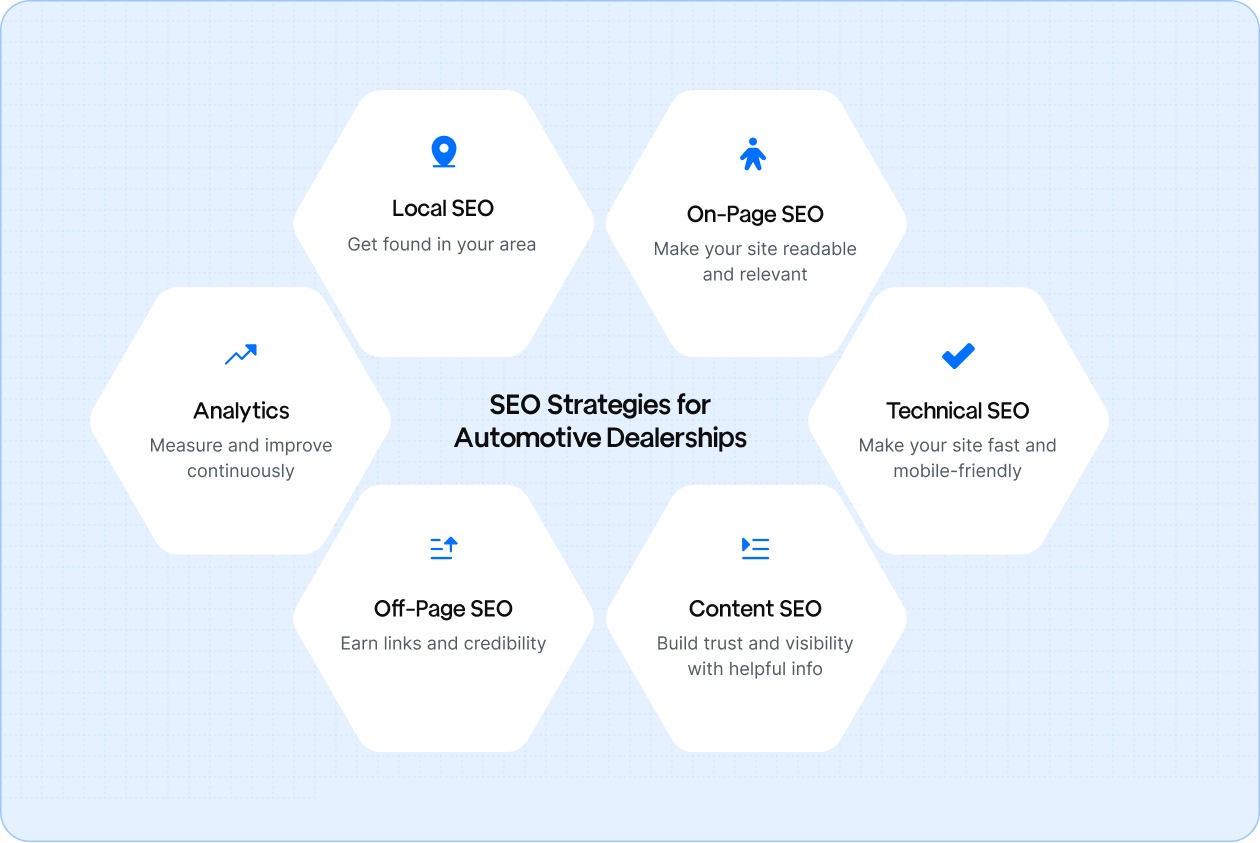
These pieces work together like a sales funnel: visibility → trust → visits → leads.
When your website, listings, and local search results work together, you earn trust before the buyer even arrives. Small, steady improvements to these details create big shifts in how often buyers find and choose you.
If your dealership is serious about growth, your SEO should work as hard as your sales team. Optimize it once, maintain it consistently, and let it keep doing what it’s built for, bringing the right people straight to your lot.
Automotive SEO focuses on dealership-specific elements like vehicle detail pages (VDPs), inventory feeds, and local service areas. It’s more structured than general SEO because it involves live data like prices, mileage, and vehicle availability.
You’ll typically see early visibility improvements in 60–90 days, but stronger organic leads build over 4–6 months. The more consistent your updates and data accuracy, the faster results compound.
Yes, SEO complements your paid campaigns. PPC brings instant traffic, while SEO builds long-term trust and visibility that continues even when ads are paused. Together, they improve lead quality and reduce cost-per-acquisition over time.
At least once a month. Add new vehicles, post local updates, refresh your photos, and update pricing or hours. Regular updates signal activity to Google, helping maintain and improve rankings.
Neglecting their Google Business Profile or letting duplicate inventory pages confuse search engines. Keeping your GBP active and your site clean, fast, and consistent will outperform heavy ad spend in the long run.

Most chimney sweep businesses flourish through a good reputation, yet struggle with visibility. You might do excellent work, clean flues, safe fireplaces, satisfied homeowners, but still find it difficult to get a steady flow of new bookings. That’s where the right marketing and content strategy steps in.
A solid online presence ensures people find you before they even search for your competitors. And with a strong content foundation, every photo, review, and service page can work together to build trust long before you pick up the phone.
In this blog, you’ll learn what makes an effective chimney sweep content marketing plan and how to turn those efforts into consistent leads through proven marketing strategies.
Homeowners choose chimney pros they can find, trust, and understand. Chimney sweep content marketing helps you show up in local search, explain your services, and turn one-time cleanings into repeat bookings.
Here’s why it’s worth your time:
When someone searches for “chimney cleaning near me,” you want your name to appear before others. If you have clear, complete information online, more homeowners will find you instead of your competitors.
Most calls come in during fall and winter. But if people can find you online for other services like animal nest removal or masonry repair, you can get steady work all year.
Showing real photos, reviews, and short explanations of your services helps people see you as a professional, not just another name in the listings.
When your website clearly says what you do and what areas you serve, the people who contact you already know what to expect. That means fewer wasted calls and more real jobs.
The more people see your name online, on Google, on maps, or through shared posts, the more familiar and trustworthy your business looks.
Bottom line is, consistent, helpful content makes you easy to find, easy to trust, and easy to book, exactly what busy homeowners want from a chimney professional.
Now that you understand why it matters, let’s look at what makes an effective content foundation.
Strong SEO makes your content easy to find, trust, and act on. Use these building blocks to rank in local search and turn visits into bookings.
Before you spend time on ads or social media, make sure people in your area can actually find you online. Most homeowners look for a chimney sweep nearby, and they usually click on the first few results they see, often in Google Maps or Apple Maps.
That’s why your business info needs to be clear and consistent everywhere it appears.
Here’s what to focus on:
When someone looks you up online, the website should show what you do, where you work, and how to reach you, fast. Make sure to write clear, useful pages that answer the main questions a homeowner has.
You might hear people talk about “on-page SEO” or “on-page optimization.” All that really means is making sure the words and pictures on your website clearly explain what you do, where you work, and who you serve.
Here’s how that works in practice:
Your website is often the first time a homeowner “meets” your business. If it takes too long to load, looks broken on a phone, or doesn’t feel reliable, people leave and call someone else, even if you’re the better choice.
Here’s what a good website should do:
1. Load Quickly: When someone clicks your website, it should open in just a few seconds. A fast website tells customers that your business is up to date and professional.
2. Work Smoothly on Phones: Most homeowners will search for you on their phone, not a computer. That means your website should fit neatly on small screens, with no zooming, scrolling side-to-side, or cut-off text.
3. Show You’re Legitimate: People want to know they’re letting the right person into their home. Your website should make that clear right away.
Simple things make a big difference:
These touches make homeowners feel safe and confident calling you.
4. Make Contact Easy: Once someone decides they want to hire you, don’t make them search for how to do it. Add clear buttons or links that say it directly.
One way it decides who to trust is by seeing where else your business name appears online and who’s talking about you.
That’s what “local links” and “mentions” mean: other websites mentioning or linking to your business because you’re known and active in your area. Here’s how to do it:
1. Get Listed in Local Directories: Start with the simple stuff. Make sure your business is listed on well-known local sites where people look for home services.
2. Partner with Other Local Pros: You probably already work with roofers, masons, home inspectors, or realtors. Those connections can also help your online presence.
Here’s how:
Each of these mentions (called backlinks online) helps your business show up higher in search results because it signals trust and community connection.
3. Show Up Locally, Both Online and Offline: Community presence goes a long way. You don’t have to spend a lot, just be visible and active in your area.
These small efforts often lead to local mentions and every mention helps your business look more established online.
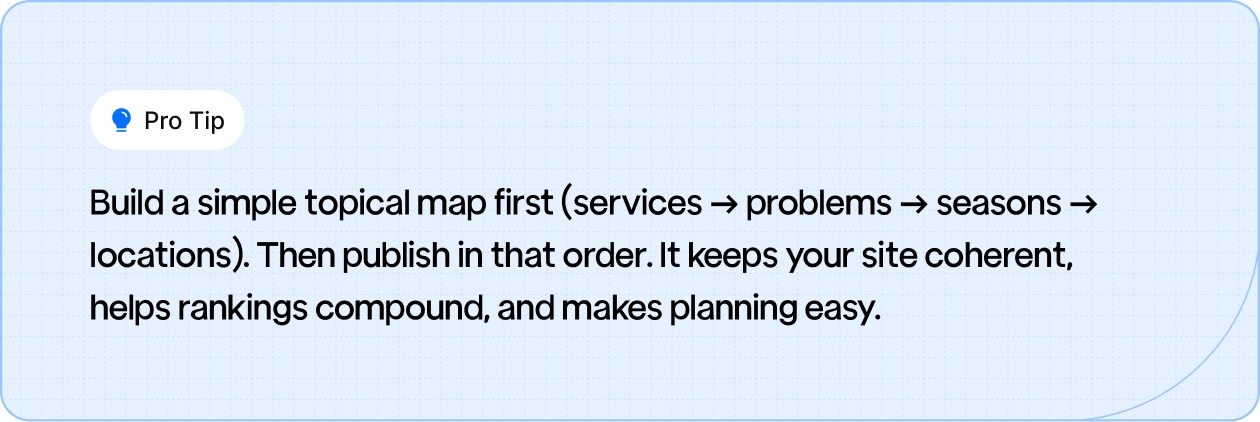
Your foundation sets the stage. It’s time to put it to work.
Content alone won’t fill the schedule. You also need smart distribution, trust signals, and repeatable systems that reach homeowners at the right moment. These strategies focus on execution, how to get in front of local demand and convert it into booked inspections and repairs:
Homeowners often search when they have an urgent issue (smoke in room, animal in flue, draft problems). LSAs give top placement, and Search ads capture those still exploring options.
How to execute:
Action: Allocate budget to LSAs first, then add Search ads. Review lead quality every week and shift spend to the channels bringing booked jobs.
Many chimney bookings come via Realtors, home inspectors, HVAC companies, or masons who enter homes during inspections or remodels. A partnership expands your reach.
How to execute:
Action: Identify 3–5 local Realtors/home-service businesses, present a partnership offer by the end of the month, and track referrals monthly.
Before booking, homeowners want proof of work and social proof. Home services with a strong local visual presence generate healthy engagement.
How to execute:
Action: Take 3 photos at each job (before, during, after), draft a social post template, and schedule 2 posts/week.
Chimney demand is seasonal: inspections before winter, repairs after, caps in summer. Offers tied to timing encourage early bookings and reduce rush.
How to execute:
Action: Choose your next season offer, design a landing page, and schedule ad/social push 30 days out.
Real job proof builds credibility and supports content marketing. Low-cost, high-impact when standardized.
How to execute:
Action: Equip your crew with a job capture checklist. Post one Project Spotlight per month.
Many homeowners forget to book the next inspection; automated follow-ups make you the default choice.
How to execute:
Action: Choose your CRM/tool, build two templates: post-job review request and annual reminder, schedule their send.
What gets measured gets improved. Knowing which ads, social posts or referrals convert into jobs helps you invest smartly.
How to execute:
Action: Set up a monthly “Channel Review” spreadsheet, define baseline metrics this month, and decide next month’s budget allocation based on results.
Pair findability (LSAs, search, neighborhood apps) with trust (reviews, video, partners) and frictionless booking (clear pricing, short forms). That combination is what keeps your calendar full, without relying only on peak-season rush.
The opportunity is there every season. Keep refining your message, keep sharing your best work, and let your marketing become an extension of your craftsmanship: consistent, dependable, and built to last.
Content marketing is a long-term strategy, but you should start seeing improvements in local search rankings and bookings within 3 to 6 months. The more consistent and relevant your content, the quicker the results.
Yes! Sharing before/after photos, educational posts, and project spotlights on platforms like Instagram and Facebook helps build local trust, engage customers, and promote your services.
Google reviews are critical for local SEO and trust-building. Positive reviews directly influence your rankings in the local map pack and reassure homeowners that you’re a trusted professional.
For seasonal content, create posts that remind homeowners about pre-season inspections (fall), safety checks (winter), and cleaning services. You can also provide helpful tips on how to prevent chimney damage during each season.
Building partnerships with local businesses such as roofers, realtors, and property managers is a great way to gain referrals. You can co-create content, share your services with their clients, and offer incentives to generate more leads.
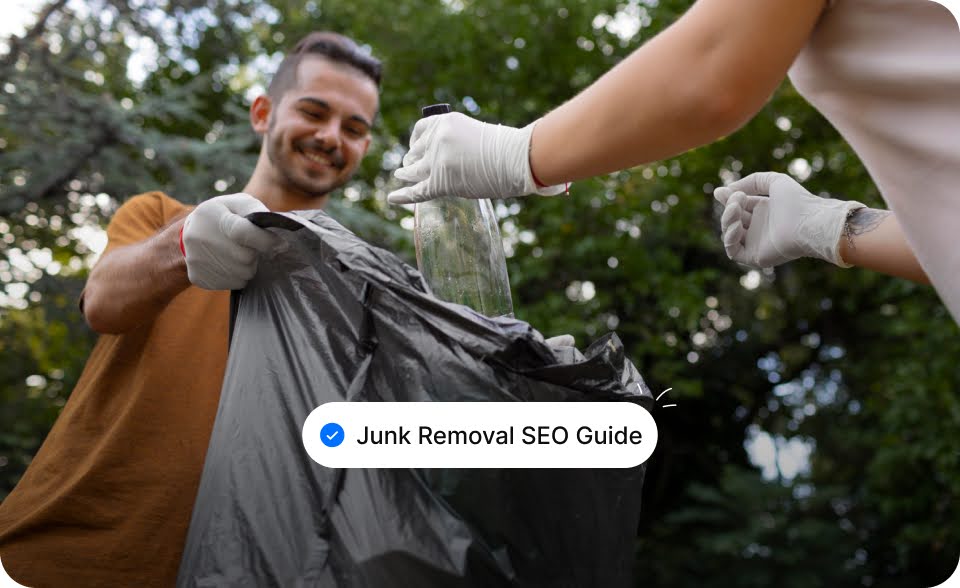
A homeowner moves into a new place, only to find the garage filled with unwanted items. They search for "junk removal near me" on Google, hoping to find help. If your junk removal business doesn’t appear in those results, you miss the opportunity to connect with potential customers at the moment they need you.
Junk removal SEO ensures your business shows up when it matters, helping you attract inquiries and build lasting customer relationships.
This blog will guide you through the most effective SEO strategies to help your junk removal business rank higher in search results and attract more residents.
Junk removal SEO is the process of improving your online presence so that your business ranks higher when potential customers search for services you offer. It involves optimizing your website, content, and local listings to ensure you appear in relevant search results.
Effective SEO is about creating high-quality content, ensuring your site is technically sound, and building trust through backlinks.
With search engine algorithms constantly changing, a personalized, expert approach helps you adapt and stay visible, ultimately driving more customers and increasing your credibility.
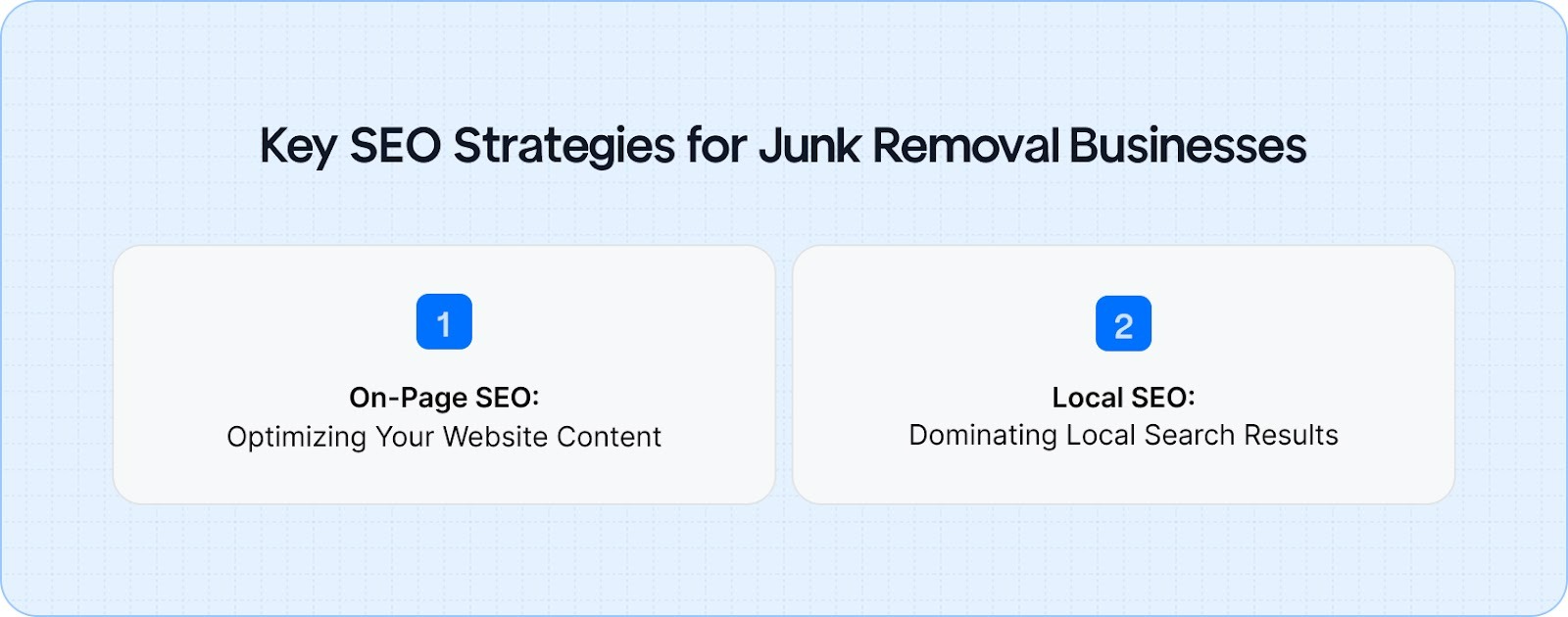
When it comes to junk removal, attracting the right customers at the right time is key. But optimizing your online presence is not as simple as just adding a few keywords.
SEO is a dynamic strategy that requires ongoing effort, an understanding of best practices, and the ability to adjust quickly to changes in search engine algorithms.
Let’s break down the key strategies that will ensure your business stands out in search results and brings in the inquiries you need.
On-page SEO ensures your website content is both customer-friendly and search engine-friendly. Below are key components to optimize:
Keyword Research: Finding the right keywords is crucial, but relying on broad terms like “junk removal” won’t bring the most qualified customers. Focus on long-tail, service-specific keywords to attract customers actively looking for what you offer.
Tools for keyword research:
Once you find your keywords, knowing how to integrate them effectively into your website is essential for maximizing their impact.
Content Optimization: Personalize each page to address specific customer needs, and ensure the content is optimized for SEO.
Page Speed: Ensure your site loads quickly on all devices. Search engines favor fast-loading websites, and potential customers won’t stick around if your site is slow.
As you continue optimizing your website, staying ahead of keyword trends and adapting your strategy to changing SEO practices is essential.
When customers search for junk removal services in their area, appearing in local search results is essential. Local SEO ensures that your business ranks high in searches like “junk removal near me” or “affordable junk removal in Boston”.
Google Business Profile (GBP) Optimization: Your Google Business Profile is the foundation of your local SEO. Here’s how to optimize it:
Apple Business Connect: Optimizing your business for Apple Business Connect ensures visibility in Apple Maps, which is an increasingly popular tool for iPhone users searching for local services.
Local Keywords and Citations:
By effectively implementing on-page SEO and local SEO strategies, you can ensure your junk removal business ranks higher and attracts more customers in your area.
SEO is an ongoing process, and adapting to trends and optimizing your content continuously is key to maintaining a competitive edge.
To truly stand out and stay visible in search results, advanced strategies like targeting featured snippets, building authority, and establishing trust are essential. Implementing these strategies requires skill and careful planning.
Without the right approach, your business could miss out on valuable opportunities.
Let’s take a deeper look at these advanced tactics and how they can help your junk removal business rank higher and drive more inquiries.
Featured snippets are the boxed answers that appear at the very top of the search results, often in position zero.
They are a powerful tool for driving traffic because they place your business in the most visible spot on Google’s results page.
Why Featured Snippets Matter?
Appearing in a featured snippet means that Google sees your content as the best answer to a specific question. For junk removal businesses, this can lead to a significant increase in website traffic, as your services will be placed in front of customers actively searching for help.
How to Optimize for Featured Snippets:
Achieving featured snippets requires continuous content updates and optimizations. With the right expertise, your website can maintain its position at the top of search results, driving traffic and generating inquiries.
For your junk removal business to succeed in SEO, you need to demonstrate your expertise. This means creating high-quality content that answers questions, provides solutions, and shows real-world experience.
Building Backlinks for Authority
To be recognized as an authority by search engines, you must build high-quality backlinks.
Trust Signals
Trust is vital in SEO. Google favors websites that appear credible and reliable.
Backlink building is a time-consuming effort, but without a strategy, it can be overwhelming. Keeping up with new opportunities and ensuring you’re following the right techniques is critical for success.
Tracking and measuring the success of your SEO efforts is essential to ensure you’re on the right path and making the right adjustments. Without proper tools and metrics, it’s hard to gauge the effectiveness of your strategies and see where improvements are needed.
Here’s how you can track your SEO success with clarity and confidence.
Google Search Console is one of the most powerful, free tools available to understand how your website is performing in search. It provides valuable insights into how Google views your site and where you stand in search results.
This can help identify content that resonates with users and content that needs improvement.
Search Console helps you pinpoint which pages are performing well and which need optimization to better meet your customers' needs.
Once visitors arrive at your site, tracking what they do next is crucial. Google Analytics lets you measure the effectiveness of your SEO campaigns by tracking specific actions, such as form submissions or phone calls.
By setting up these conversion goals, you can measure the true impact of your SEO efforts in terms of actual customers and sales.
To truly stay ahead of the competition, you need to know where your site ranks for important keywords.
Tools like SEMrush and Moz provide in-depth keyword tracking and insights that help you adjust your SEO strategy as needed.
Knowing how you stack up against competitors allows you to tweak your strategy and improve your chances of outranking them.
Junk removal SEO works best when every part of the strategy fits together: service-focused content, strong local signals through Google Business Profile and Apple Business Connect, technical improvements, and steady authority building through backlinks.
When these elements align, search visibility improves, more local customers discover the business, and inquiries flow becomes far more consistent.
The next step is simple: begin applying these tactics, track performance regularly, and refine what works. SEO success compounds over time, and businesses that stay committed often see remarkable long-term gains.

Running an appliance repair business means you’re always on the go, fixing appliances, managing clients, and staying on top of everything. But how do you ensure your business gets noticed when people need you most?
Appliance repair SEO helps your business show up at the exact moment potential customers are searching for what you offer. It’s a simple, cost-effective way to bring in more leads, get noticed by more people, and connect with local customers, without piling on more work.
Let’s talk about how SEO can help you attract the right customers and grow your business.
In the appliance repair industry, visibility is everything. SEO will help you achieve it.
If your business doesn’t appear in the top search results when people need your help, you’re missing out on valuable leads.
Here’s why SEO matters:
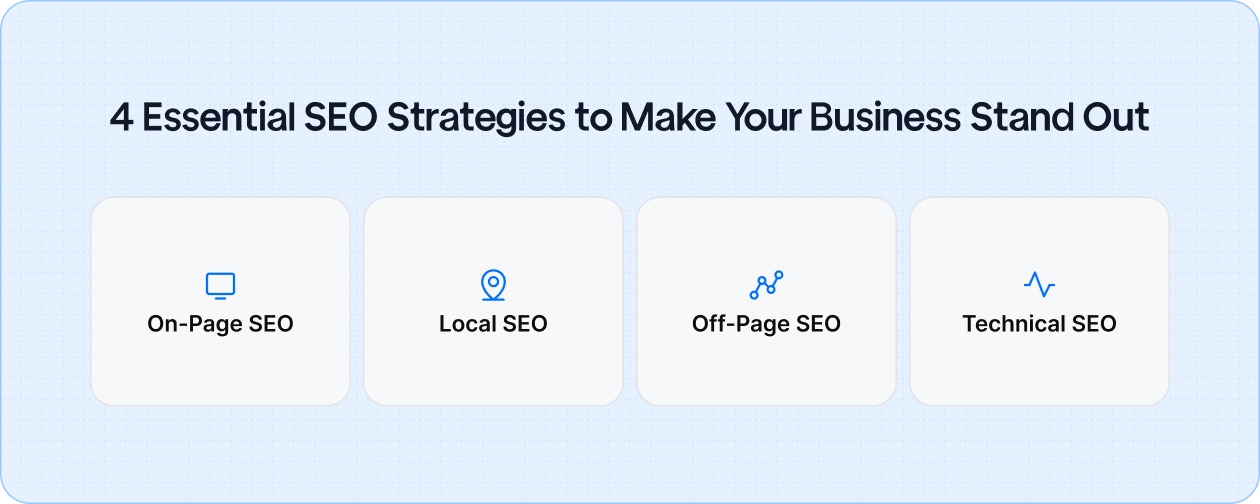
Let’s break down the essential SEO strategies that will help you get found, grow your business, and stay ahead of the competition.
On-page SEO is the foundation of your online presence. If your website doesn't match what customers are looking for, it won't appear in search results.
You need to ensure you’re using the right keywords and creating content that connects with the people actively looking for help.
Here’s how you can make it work for you:
Creating this content can be time-consuming, and it’s easy to miss key opportunities. Having the right strategy ensures you're reaching the people who need your help right when they're ready to make a decision.
Local SEO is the game-changer for appliance repair businesses. Most of your customers are nearby and looking for a local provider. If you’re not showing up when they search for appliance repair services in your area, you’re missing out on a big chunk of potential business.
Here’s how to make the most of local SEO:
By focusing on local SEO, you ensure your business shows up when people in your area need appliance repairs, helping you grow your customer base without competing with national companies.
Off-page SEO is about establishing your business as an authority in your field. One of the best ways to do this is by acquiring backlinks, links from trusted websites that point back to your site.
These backlinks show search engines that your business is reputable and worth ranking higher.
To get the right backlinks:
While these strategies can take time to develop, they’re vital for improving your site’s authority and search rankings. And, doing it right can bring long-term growth for your business.
Technical SEO focuses on the behind-the-scenes work that helps your website run smoothly. While it might seem less important than content or keywords, getting these technical aspects right is essential for your site’s performance and search visibility.
Here’s what to focus on:
These small changes can have a big impact on your rankings and user experience. But getting them right can be tricky without the right technical knowledge.
You’ve put in the work, optimized your website, focused on keywords, and built those local citations. But how do you know it’s all paying off?
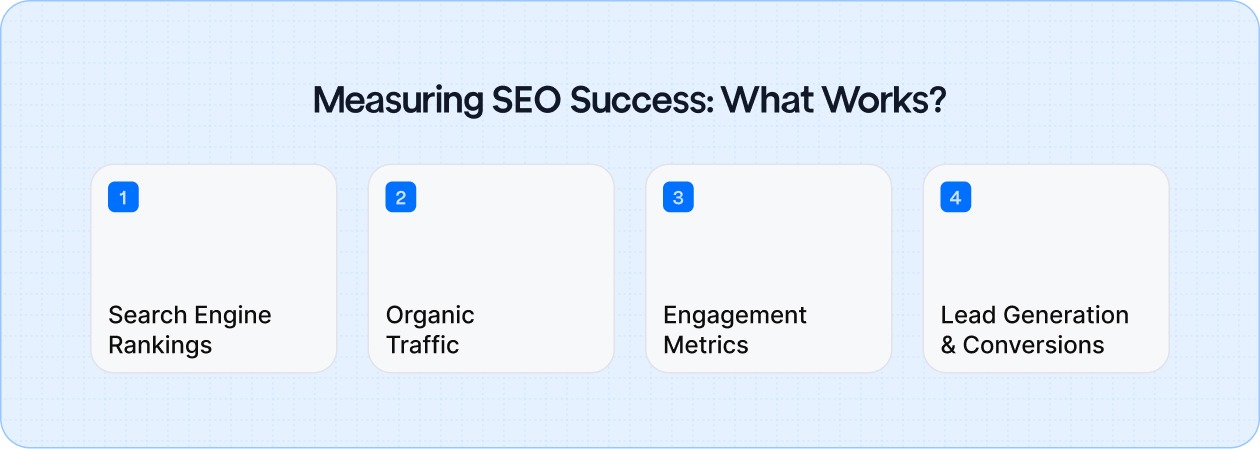
Tracking the right metrics gives you the clarity you need to understand what’s actually working and where you need to adjust.
Here’s what you should be keeping an eye on:
Using the right tools, like Google Analytics and Search Console, gives you a clear picture of where your efforts are succeeding and where you can improve.
You need to track the data, make informed tweaks, and watch your results improve.
Hiring an SEO expert ensures your appliance repair business stays visible, attracts more customers, and grows without taking time away from what you do best.
SEO is always evolving, and staying on top of the latest strategies, trends, and search engine updates can be overwhelming. Without the right expertise, it’s easy to fall behind, missing valuable opportunities to attract more customers.
That’s why many appliance repair businesses choose to partner with SEO experts who can ensure they stay visible online while focusing on delivering quality service to customers.
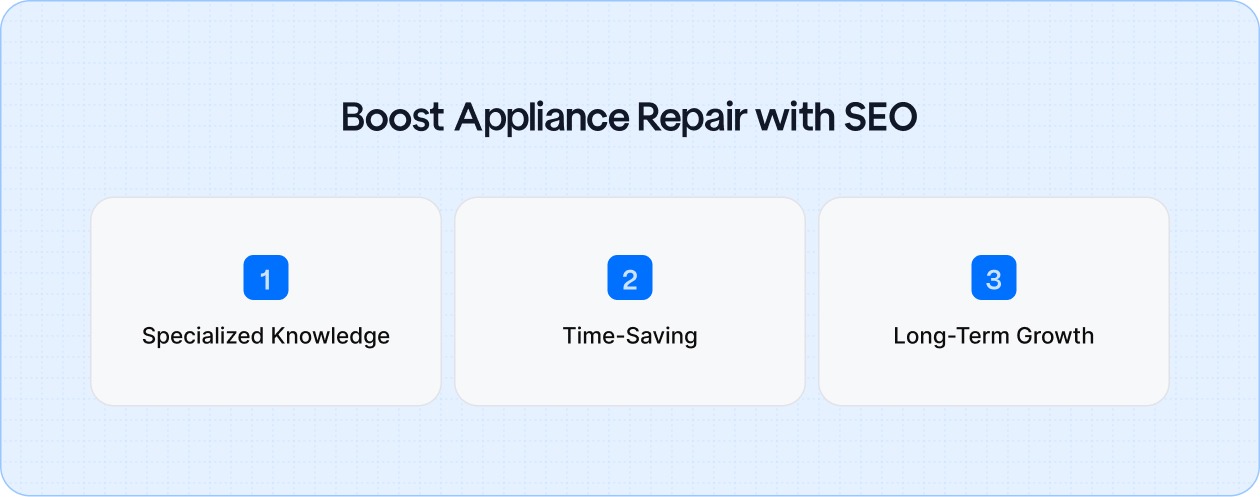
An expert helps build a sustainable, long-term strategy that drives growth for your business. Here’s why hiring an SEO expert makes sense:
At some point, it makes sense to let the professionals handle the heavy lifting. Teams like Gushwork specialize in SEO strategies that are personalized to small businesses like yours.
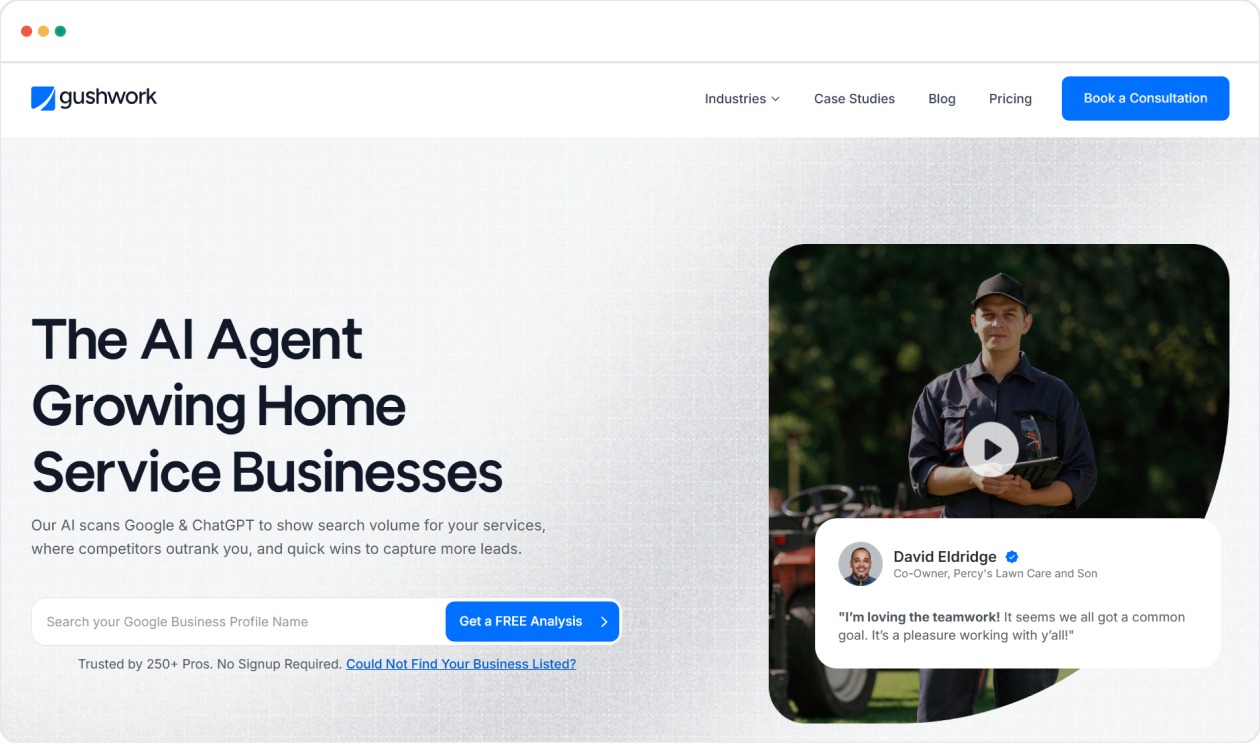
With their expertise, you can feel confident that your online presence is in good hands, allowing you to focus on delivering the best service to your customers without the added stress of SEO management.
A1. These services involve optimizing your online presence so people who need repairs can find you when they search. It covers things like improving your website content, making sure your business shows in local results, and helping search engines understand what services you offer.
A2. SEO isn’t instant, but if you stick with the strategy and keep your site updated, you’ll usually start seeing more visibility and inquiries within a few months. The exact timeframe depends on how competitive your area is, how many reviews you have, and what your website looks like now.
A3. Absolutely. Many service‑based businesses that don’t have huge marketing teams invest in tailored, cost‑effective SEO plans. The key is focusing on the services your customers are searching for and optimizing the parts of your business site that matter most.
A4. Paid ads bring immediate visibility, but SEO builds lasting presence. For many appliance repair businesses, combining both works best, with ads for urgent jobs and SEO to consistently attract customers over time.
A5. Yes. Fresh, relevant content helps search engines understand your services and shows you’re active. But it doesn’t mean you need a full blog every week; just a few useful updates, service pages, and local content can make a big difference.
A6. Look for someone with experience in local services, especially home repair or technicians. They should understand your service area, your customers’ needs, and how people search for quick, trustworthy appliance repair help.
A7. You’ll see signs like more visits to your website, more phone calls or form submissions, and better visibility when you search keywords related to your services. The right expert will show you the data clearly and help you decide what to improve next.

The key to grow your carpenter business lies in making sure the right clients can easily find you when they're ready to bring your expertise into their homes or projects.
SEO for carpenters makes sure your business shows up when potential clients are searching for what you offer. With the right strategies, your business can stand out online and attract the customers who need your expertise.
Let’s explore how SEO can help your carpentry business grow by connecting you with customers actively searching for your services.
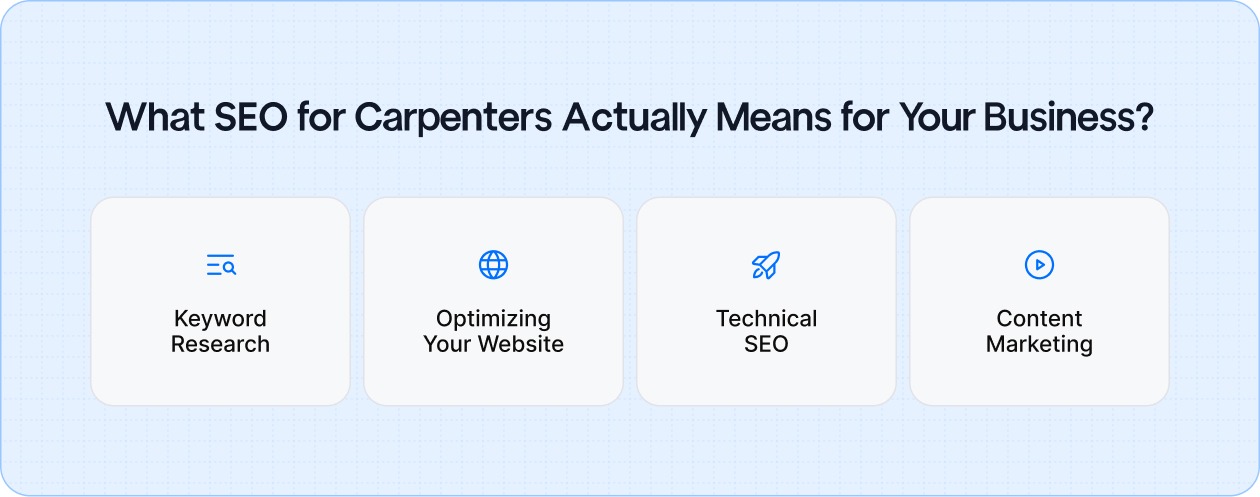
SEO is the key to making sure your skills are seen by the customers who need them. By implementing the right strategies, you can increase your online presence and make it easier for people to find your services when they search.
Start targeting the terms your potential customers are actually using. Learn how to identify the words and phrases that lead customers directly to your business, so you’re not wasting time on the wrong searches.
Your website is a tool to connect with customers. Learn how to make sure it’s set up to be found by search engines and designed to turn visitors into leads.
Website speed, mobile compatibility, and structure are essential for ensuring customers have a smooth experience when they visit. Get the inside scoop on how these factors impact your SEO rankings.
Your content is a chance to show your expertise and attract the attention of both Google and your potential clients. Learn how to create content that resonates with your audience and gets you noticed.
Local SEO is essential for carpenters aiming to attract customers in their community. If your business isn’t appearing in local searches, you’re losing out on valuable opportunities.
Here’s how to make sure you stand out when customers nearby need your services:
Optimizing your Google My Business and Apple Business Connect profiles is critical for local visibility. These platforms make it easier for customers nearby to find you when they’re searching for carpentry services.
Action Steps:
For some, keeping up with these updates and making sure everything is optimized can become overwhelming. It’s easy for small businesses to miss key details that would improve visibility and trust.
Consistency in your NAP (Name, Address, and Phone Number) across all platforms is crucial. Google values uniformity, and your customers rely on it to contact you easily.
Action Steps:
Small mistakes or inconsistencies can easily slip through the cracks without expert help.
Ensuring your NAP is aligned across the web may take some effort, but it can make a significant difference in search results.
Local keywords help your business appear when customers in your area search for carpentry services. These terms show Google that you serve a specific location and are ready to take on nearby projects.
Action Steps:
Identifying the right keywords and ensuring they’re strategically placed can require a comprehensive strategy that targets the right terms. This often needs a professional approach to really make it work for your business.
Backlinks are a key factor in SEO, signaling to Google that other reputable websites trust your content. These backlinks improve your authority and show search engines that your business is credible and worth ranking.
High-quality backlinks are essential for getting noticed by Google. These links act as "votes of confidence" from reputable sites, showing that your business and content are trusted.
Action Steps:
Customer reviews do more than build trust; they directly impact your SEO. Google values fresh, positive reviews, which can improve your visibility in search results.
Action Steps:
SEO is a continuous process that requires constant monitoring. If you’re not tracking your progress, how will you know if your efforts are truly working?
Here’s how to ensure your SEO strategy is driving the results you need.
Google Analytics is like a treasure map for your website. It shows you exactly where your visitors are coming from and what they’re doing once they arrive. Understanding this flow is crucial for refining your strategy.
Action Steps:
Google Search Console gives you a behind-the-scenes look at how Google views your website. It’s your best tool for understanding which keywords are driving traffic and where your rankings are improving, or falling short.
Action Steps:
Even with the best craftsmanship, your business can hit a wall if your SEO isn’t on point. The digital world is competitive, and small missteps in SEO can put your carpentry business at a disadvantage.
Let’s look at the common mistakes carpenters make, and why avoiding them is crucial for staying ahead of the competition.
It’s easy to overlook local SEO when you’re focused on perfecting your craft, but not optimizing for your local area can seriously impact your business.
If you aren’t using location-based keywords like "carpenter in Chicago or setting up your Google My Business profile, you’re missing out on clients right in your neighborhood.

Keyword research is key to understanding exactly what potential clients are searching for. Using vague or irrelevant keywords might attract traffic, but it won’t be the kind of traffic that converts into leads.
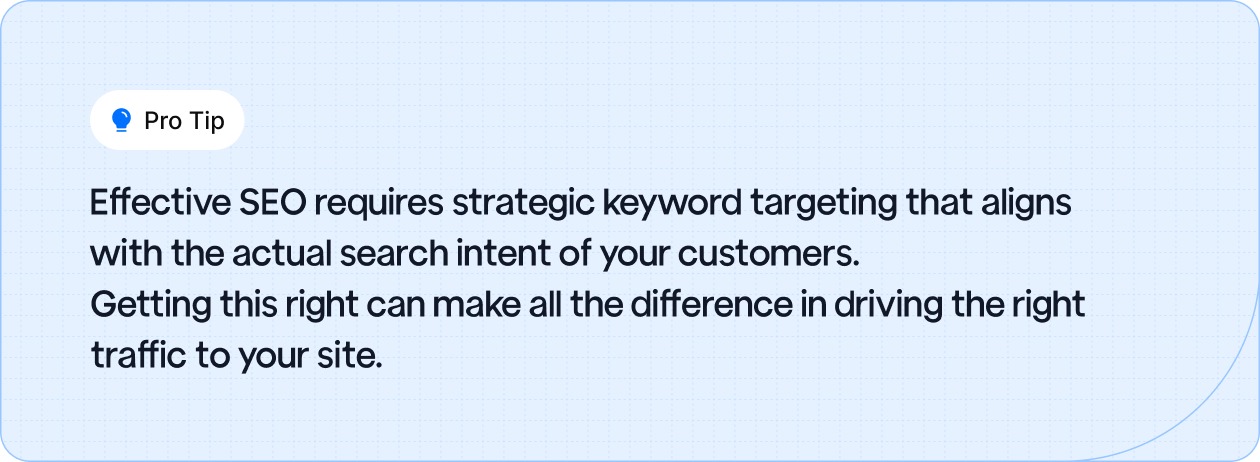
A slow website or one that’s hard to navigate on mobile is a fast way to lose clients. People expect your site to load quickly and work seamlessly on any device. If your website doesn’t meet these expectations, visitors will leave, and Google will lower your rankings.
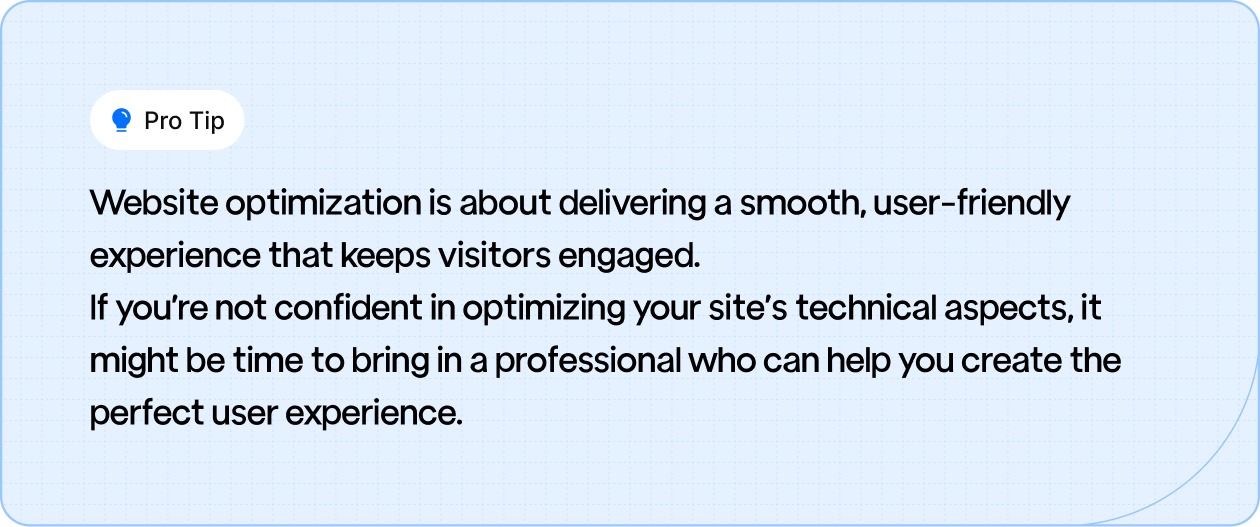
You need to showcase your expertise and provide value to your audience. A lot of carpenters neglect content marketing, focusing only on their services. Without consistent, well-crafted content, you won’t build the authority needed to rank on Google.
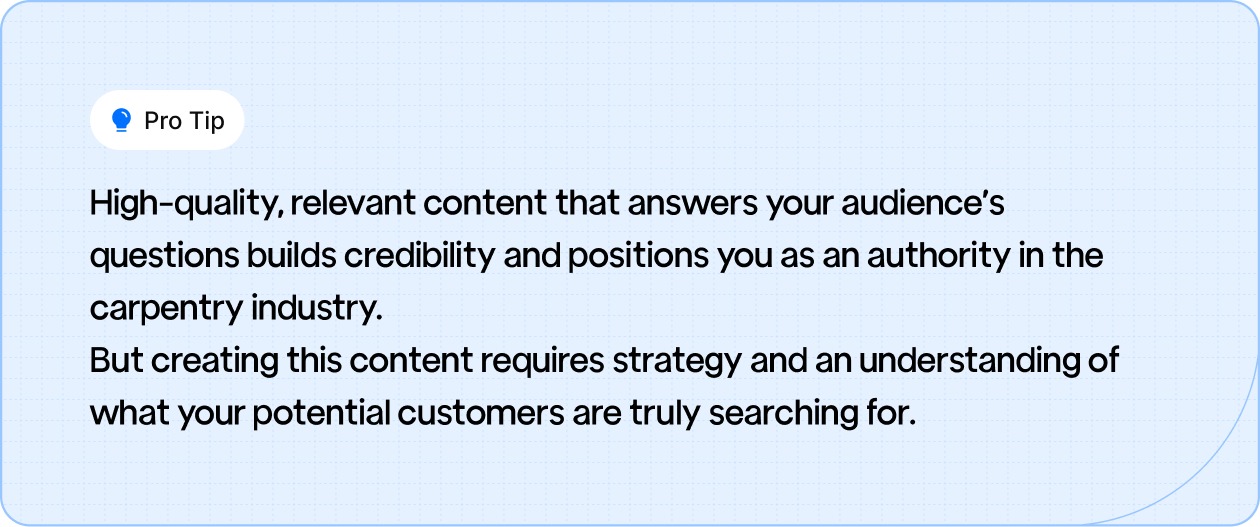
Backlinks are one of the most important aspects of SEO. Without them, your website won’t gain the authority it needs to rank highly.
Many carpenters ignore the value of backlinks or don’t know how to get them.

SEO takes time, strategy, and often the expertise of professionals to ensure your carpentry business is positioned for success in search results. As you fine-tune your website and strategy, remember that taking a holistic, ongoing approach is key.
With the right support, you can overcome these common mistakes and start driving the qualified traffic that turns into customers.
If you’re unsure where to start, consider working with a team that understands the ins and outs of SEO, so you don’t have to do it alone.
SEO is an essential tool for increasing your carpentry business's online visibility. When you optimize your website, you make it easier for customers to find you exactly when they need your services.
By applying these SEO strategies, you can improve your rankings and connect with clients who are searching for your expertise.
SEO can be challenging and time-consuming, especially when you're focused on your work. Gushwork specializes in content-driven SEO strategies that help small businesses like yours grow and get noticed online.
A1. SEO for carpenters means making sure your business appears when local customers search for services you offer. It involves choosing the right keywords, optimizing your website and listings for search engines, and creating content that reflects your craftsmanship and service area.
A2. The timeframe varies depending on competition and the work required, but most small carpentry businesses begin seeing improved visibility and inquiries within 3 to 6 months, provided the SEO is consistent and well‑focused on local search and service‑specific keywords.
A3. Yes, regular updates help. While your site’s core services pages might stay the same, adding new content, such as project case studies, service updates, or blog posts, signals activity and relevance. This keeps search engines more confident that your business is active and trustworthy.
A4. You can handle some basic SEO elements yourself, such as claiming your local listings and making sure your address and service descriptions are consistent. But to get lasting results, there are technical, content and backlink factors that often require a level of expertise or external support.
A5. The most frequent error is using generic or overly broad keywords (like “carpenter” or “woodwork”) instead of service‑and‑location focused terms (e.g., “custom kitchen cabinets in Chicago”). Without targeting what your customers are actually searching for, you'll miss the most relevant traffic.
A6. Extremely important. Listings such as Google My Business and Apple Business Connect, combined with genuine customer reviews, strengthen your business’s local presence and trustworthiness. They help you show up in local search results when customers are looking for carpentry services near them.
A7. Absolutely. If your website loads slowly or doesn’t work well on mobile devices, you risk losing prospects right away, and your search visibility can suffer. These technical aspects are often overlooked but make a meaningful difference in how you’re seen online.

To grow your flooring business, gaining visibility online plays a key role in reaching new customers. As more people turn to the internet to find services, you need to be easy to find and relevant to your target audience. The right SEO strategies can help with that.
By improving your position on search engines, you increase the chances that potential customers will find your business. This attracts more qualified visitors, those actively searching for flooring services.
Once they arrive, the goal is to convert these visitors into loyal clients. This guide will explore practical SEO techniques to help your flooring business expand and succeed.
Understanding how homeowners search for flooring services is crucial for aligning your SEO strategy with their needs. Homeowners typically go through a journey, starting with research on flooring options, then comparing prices, and finally seeking trusted professionals.
This search behavior is predictable and actionable, and by mapping out this journey, you can tailor your SEO efforts accordingly.
Actionable Steps:
A flooring business's website needs to load quickly, be mobile-friendly, and optimize for images to stay competitive. Many flooring sites overlook key elements such as page speed, mobile optimization, and image SEO, all of which can result in lost traffic and potential customers.
Flooring websites are often heavy with images of products; it's crucial to optimize page speed. If your website is slow to load, you risk losing potential customers to competitors who offer a faster, smoother experience.
Customers expect fast-loading websites, especially when browsing for services they need immediately.
Key Focus Areas for Technical SEO:
Local SEO is a must for flooring businesses. Google prioritizes businesses that are geographically close to searchers. Without proper local optimization, you miss out on customers actively searching for flooring services in their area.
Apple Business Connect also plays a role in local visibility. As more people use Apple Maps to search for local services, ensuring your business is listed correctly on both Google and Apple is critical.
Local SEO is a vital strategy that includes optimizing your Google Business Profile, Apple Business Connect and ensuring that your NAP (name, address, phone number) details are consistent across directories.
Key Steps for Dominating Local SEO:
Flooring customers want detailed, specific information. The key is to create service pages that rank and convert visitors into leads.
Each service page should be highly targeted and organized to answer the exact questions your customers are asking. This approach improves SEO and enhances the user experience by giving visitors exactly what they need to make a decision.
Components of a High-Converting Service Page:
Each product in your catalog is a ranking opportunity. Flooring products like hardwood, tile, and vinyl each provide unique opportunities to target specific searches. When your product pages are optimized with relevant keywords and useful information, you transform your catalog into an SEO tool that generates traffic.
You can make each SKU a potential lead generator by adding useful content like specifications, use cases, installation methods, and maintenance tips.
How to Optimize Product Pages for SEO:
Blogs like “SEO tips for flooring companies” rank well because they answer real, actionable questions homeowners and businesses have. When you provide valuable, targeted content that addresses your audience's specific needs, your site becomes a trusted resource, driving both traffic and conversions.
To build a content engine that attracts the right customers, start by focusing on 7 core blog categories:
How to Map It Out:
Visual content, such as images and videos, plays a key role in a flooring business’s online presence. When optimized properly, visual assets can enhance engagement and support your SEO goals.
Key Areas to Focus On:
Many flooring businesses focus too much on high-volume and broad keywords. While those keywords can help with visibility, they don’t always capture the intent of customers ready to make a purchase.
To truly rank and attract qualified leads, focus on intent-led keyword clustering.
Steps to Enhance Keyword Research:
User experience (UX) plays a significant role in SEO. Google’s algorithms prioritize websites that provide a seamless, engaging experience for users.
A poor UX leads to higher bounce rates and missed opportunities. Making sure your website is mobile-friendly, easy to navigate, and fast is crucial for keeping visitors on your site longer and for encouraging them to convert.
Key Areas to Focus On:
Backlinks remain a key ranking factor in SEO, but it’s important to focus on quality over quantity. Local backlinks from trusted sources in your community can help elevate your authority and visibility.
These backlinks signal to search engines that you’re a credible business serving the local community.
Effective Ways to Build Local Backlinks:
Featured snippets and the "People Also Ask" (PAA) box are prime opportunities to increase visibility. These sections appear at the top of search results, often driving a significant portion of the click-through traffic.
However, many flooring businesses overlook how to capture them. It’s time to systematize this process and make it a key part of your SEO strategy.
Identify Snippet-Worthy Questions:
Content Structure for Featured Snippets:
Why It Works: Google favors content that directly answers common questions, especially when paired with clear, well-structured explanations.
By addressing these queries and using structured data, you set yourself up to claim top spots in search results.
AI is transforming how we approach SEO, but it’s important to understand that AI should support, not replace, human effort. Flooring businesses can use AI-driven tools to enhance their SEO workflow while ensuring quality control remains in place.
Use Cases for AI in SEO:
Guardrails for AI Use:
For flooring brands with multiple showrooms or service territories, scaling SEO effectively is crucial. Having two locations or fifty requires a personalized SEO strategy for multi-location optimization, all while maintaining a consistent brand message.
Key Considerations for Multi-Location SEO:
This structure allows search engines to index your pages more effectively and ensures local searchers easily find each location or service.
Why It Works: Scalable SEO for multi-location businesses requires a balance of consistency and local relevance.
A structured approach to site architecture and content will help you rank across multiple locations without losing your brand’s core identity.
By now, you've got 13 solid strategies in your toolkit to help your flooring business climb the ranks on Google. Attracting the right customers starts with refining your content to address their questions and optimizing your local presence.
Each step moves you closer to building a reliable, consistent flow of leads.
The key to lasting SEO success is having the right tools and approach. When you align your efforts with the right strategies, you'll see how much smoother the process becomes, leaving you with more time to focus on growing your business and serving your clients.
A1. Aim to respond within 15-30 minutes if possible. Homeowners often decide quickly when they start searching. A prompt response increases your chances of booking the job.
A2. Platforms like local directories and lead marketplaces can help, but they charge per lead, and you’ll still be competing with others. Many professionals see better ROI by improving their own website, Google Business Profile, Apple Business Connect and leveraging referrals.
A3. Focus on intent‑rich phrases like:
These capture users deeper in the decision process, not just those window‑shopping.
A4. Absolutely. Flooring is visual by nature, so high‑quality before/after images, optimized file names, and alt text help your SEO and build trust with potential customers. Contractors have reported better engagement after focusing on visual content in local listings.
A5. Not if you structure your site correctly. Create dedicated pages for each service area, and ensure your service‑area details, NAP (name, address, phone number), and local content are consistent across all pages. This approach works well even with a single physical location.
A6. Referrals remain one of the strongest sources of quality leads. A recommendation from a friend or trusted contractor carries built‑in credibility. Combining referrals with a strong online presence can help keep a steady flow of business.
A7. Use distinct tracking mechanisms:
This data helps optimize your marketing efforts and prevent wasted spend.

Social media marketing can be a powerful tool for landscapers and lawn care providers, even for small businesses with limited resources.
By consistently sharing photos of your work, offering helpful tips, and engaging with your local community, you can connect with potential customers and grow your business.
This guide will show you how to make the most of social media to get noticed and turn online interactions into real customers, without needing a large marketing team.

Choosing the right platforms ensures your time and money are spent reaching the right people. Facebook, Instagram and TikTok provide cost-effective opportunities for local businesses like plumbing.

Before-and-after photos grab attention and demonstrate your expertise. It’s a visual way of proving your worth to potential customers.

Local engagement is vital, and geo-tagging ensures that people in your area find your posts when searching for services.

Positive customer feedback reassures potential clients that you’re a trustworthy choice for their needs.

Offering helpful tips keeps followers engaged while positioning you as an expert.

A content calendar ensures your social media remains active without overwhelming your team, helping you maintain consistent engagement.
Having a well-planned calendar can make a world of difference. An expert can ensure your strategy is well-aligned with your business goals and helps you maintain consistent content.

These short-form content formats help create a more personal connection with your audience.

Paid ads allow you to target the right people, ensuring your marketing budget is spent efficiently.

Clear CTAs encourage your followers to take action and contact you for your services.
Creating the right CTAs takes practice. An expert can help you optimize them to ensure they resonate with your audience and lead to more business.
Monitoring results ensures your efforts are paying off and helps you refine your strategy for better performance.
Social media is a powerful tool for attracting local leads, building trust, and driving business growth.
By focusing on the right strategies, even small landscaping and lawn care businesses can increase their visibility, engage with their community, and turn online interactions into real-world results.
A1. For many small businesses, Facebook is the most approachable platform. You can set up a business page, share photos of your work, and join local community groups without a large budget. Instagram comes next, especially if you have strong visuals. Pick one platform to start with, post consistently, and engage with your local community.
A2. Posting 2-3 times a week is a realistic goal for a small team. Focus on quality, share a recent project photo, a tip for homeowners, or a behind-the-scenes look at your crew.
Consistency matters more than daily posts. A smaller schedule you can manage is better than a big plan you can’t keep up with.
A3. Visual proof of your work works well: before-and-after shots, short videos, or a quick post about how you solved a common yard issue. Some clients also like seeing your team in action; people hire people. Add location tags or mention neighbourhoods you serve to help local folks find you online.
A4. Yes, you can run small-budget ads that target your service area. For example, spend $5–$10/day aimed at homeowners in a specific ZIP code who might need lawn or landscaping services. Clear calls like “Get a free quote” or “See our recent work” help make your ad more effective. Track results and pause what doesn’t work.
A5. Use built-in tools in Facebook or Instagram to look at basic numbers: how many people saw your post, how many interacted, and how many reached out. Count how many messages or quote requests you get after certain posts. If one type of post consistently brings in more inquiries, do more of that.
A6. Share helpful tips (e.g., how to choose grass type, how to clean up leaves) or answer common questions homeowners ask. Join local Facebook groups and reply when people ask about yard problems; they’ll see your expertise. Avoid hard-selling in every post; helpful content builds trust and leads to business.
A7. Common mistakes include: posting rarely or irregularly, using only generic stock images, ignoring comments or messages, and choosing too many platforms at once (which dilutes your effort). Focus on one or two platforms you can manage well, show real work, engage, and update regularly.





.svg)
.svg)
.svg)